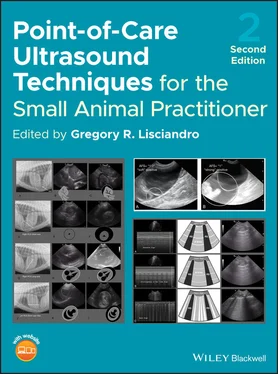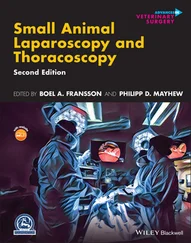– Clinical Integration Introduction What Vet BLUE Can Do Important Considerations and Limitations of Vet BLUE and Lung Ultrasound Vet BLUE Visual Lung Language Vet BLUE B‐line Scoring System Other B‐line Scoring Systems Six Signs‐Further Information Other Lines: Are They Really Lines? Clinical Use of Regional Pattern‐based Vet BLUE Approach Using the Vet BLUE “Wet Lung” versus “Dry Lung” Concept for Monitoring During Fluid Therapy Lung Contusions and Vet BLUE Pitfalls, False Negatives, False Positives, and Limitations Vet BLUE Examples Monitoring Applications for Vet BLUE The Future of Proactive Vet BLUE and Lung Ultrasound in Small Animals Recording Vet BLUE Findings on Goal‐Directed TemplatesCase Examples of Vet BLUE Advantage over Thoracic Radiography Pearls and Pitfalls, The Final Say Quick Reference of Normals and Rules of Thumb References
14 Section V: Vascular Chapter Twenty‐Four: POCUS: Central Venous and Arterial Catheterization Introduction Placement of an Ultrasound‐guided Central Venous Jugular Catheter How to Place an Ultrasound‐guided Central Venous Jugular Catheter Placement of Ultrasound‐guided Femoral Arterial Catheters and Sampling General Comments regarding Transverse versus Longitudinal Orientation How to Make a Realistic Practice Phantom Pearls and Pitfalls, The Final Say References Further Reading Chapter Twenty‐Five: POCUS: Vascular – Veins and Arteries Introduction Equipment, Materials, and General Preparation Venous and Arterial Thromboembolism Pearls and Pitfalls, The Final Say References Further Reading Chapter Twenty‐Six: POCUS: Caudal Vena Cava Introduction How to Do a POCUS Caudal Vena Cava The Three Methods for POCUS Caudal Vena Cava Image Acquisition and Measurements for POCUS Caudal Vena Cava Use of Allometric Scaling Formulas for CVC Assessment Integration of POCUS CVC Findings Inherent Differences Between Volume Status in People and Small Animals Pearls and Pitfalls, The Final Say References Further Reading
15 Section VI: Ocular, Neurological, and Musculoskeletal Chapter Twenty‐Seven: POCUS: Eye Introduction Ultrasound Settings Patient Eye Preparation How to do the POCUS Eye Ultrasonographic Findings in a Normal Eye Clinical Significance and Implications of Abnormal Findings Pearls and Pitfalls, The Final Say References Further Reading Chapter Twenty‐Eight: POCUS: Brain – Image Acquisition Introduction Ultrasonographic Anatomy Pearls and Pitfalls, The Final Say References Further Reading Chapter Twenty‐Nine: POCUS: Brain – Clinical Integration Introduction How to do POCUS Brain Sonographic Features of Traumatic Brain Injury from Trauma Sonographic Features of Brain Pathology from Nontrauma Pearls and Pitfalls, The Final Say References Chapter Thirty: POCUS: Nerve Blocks – Forelimb Introduction How to Perform POCUS Nerve Blocks – Forelimb Ultrasound‐guided Brachial Plexus: Paravertebral Approach Ultrasound‐guided Brachial Plexus Block through a Subscalene Approach Ultrasound‐guided Brachial Plexus Block through an Axillary Approach Ultrasound‐guided Radial, Ulnar, Median, and Musculocutaneous (RUMM) Nerve Block Pearls and Pitfalls, The Final Say References Further Reading Chapter Thirty‐One: POCUS: Nerve Blocks – Pelvic Limb Introduction How to Perform POCUS Nerve Blocks – Pelvic Limb Ultrasound‐guided Femoral Nerve Block in the Psoas Compartment Ultrasound‐guided Femoral Nerve Block in the Inguinal Region Ultrasound‐guided Saphenous Nerve Block in the Distal Thigh Region Ultrasound‐guided Sciatic Nerve Block Ultrasound‐guided Sciatic Nerve Block in the Lateral Thigh Region Pearls and Pitfalls, The Final Say References Further Reading Chapter Thirty‐Two: POCUS: Nerve Blocks – Trunk Introduction Ultrasound‐guided Thoracic and Abdominal Wall Blocks Ultrasound‐guided Thoracic Paravertebral Block Ultrasound‐guided Intercostal Block Ultrasound‐guided Transversus Abdominis Plane Block Pearls and Pitfalls, The Final Say References Further Reading Chapter Thirty‐Three: POCUS: Nerve Blocks – Neuroaxial Introduction Sonoanatomy of the Spine Longitudinal Ultrasound Scan of the Lumbosacral Area Transverse Ultrasound Scan of the Lumbosacral Area Longitudinal Scan of the Thoracolumbar Area Ultrasound‐guided Intrathecal Approach Ultrasound Signs of Epidural/Intrathecal Injection Pearls and Pitfalls, The Final Say References Chapter Thirty‐Four: POCUS: Musculoskeletal – Soft Tissue Introduction Equipment and Settings for POCUS Musculoskeletal – Soft Tissue Patient Preparation How To Do the POCUS Musculoskeletal – Soft Tissue Ultrasonographic Findings of Common Soft Tissue Structures Common Soft Tissue Lesions Abdominal Wall Injury or Hernia Neoplasia of Superficial Structures Pearls and Pitfalls, The Final Say References & Further Reading Chapter Thirty‐Five: POCUS: Musculoskeletal – Bones and Joints Introduction Equipment and Settings Minimizing MSK‐related Artifacts Ultrasonographic Findings in the Normal Bone, Muscle, and Tendon Ultrasonographic Findings in Diseased Bone, Muscle, and Tendon Pearls and Pitfalls, The Final Say References Further Reading
16 Section VII: Monitoring and Surveillance Chapter Thirty‐Six: POCUS: Global FAST – Patient Monitoring and Staging Introduction Ultrasound Settings, Probe Preferences, Patient Positioning, and Preparation Global FAST for Patient Monitoring Global FAST for Staging Disease – Localized Versus Disseminated Disease Global FAST Approach Case Examples Global FAST for Urinary Obstruction and Renal Failure Global FAST for Pulmonary Thromboembolism Global FAST and Anesthesia Use of Global FAST as Geriatric Health Screening Global FAST and Saving Images Pearls and Pitfalls, The Final Say References Chapter Thirty‐Seven: POCUS: Global FAST – Rapidly Detecting Treatable Forms of Shock, Advanced Life Support, and Cardiopulmonary Resuscitation Introduction Ultrasound Settings, Probe Preferences, and Patient Positioning and Preparation How to Do Global FAST The Hs Covered by Global FAST The Ts Covered by Global FAST Comparison of Global FAST and the RUSH Examination Global FAST for Rapidly Detecting Treatable Forms of Shock Final Comments on the Global FAST Approach Global FAST and Saving Images Global FAST and Goal‐Directed Templates Global FAST for Advanced Life Support and Patient Management Pearls and Pitfalls, The Final Say References Chapter Thirty‐Eight: POCUS: VetFAST‐ABCDE Introduction Ultrasound Settings, Probe Preferences, and Patient Positioning How to do the POCUS: VetFAST‐ABCDE Exam Clinical Significance and Implications of Abnormal VetFAST‐ABCDE Exam Findings Ultrasound‐Guided and ‐Assisted Procedures POCUS: VetFAST‐ABCDE in Shock Syndrome, CPR, and ALS Pearls and Pitfalls, The Final Say References
17 Section VIII: Felines and Exotic Species Chapter Thirty‐Nine: POCUS: Feline Differences – Abdomen and Thorax Introduction Feline Abdomen Feline Thorax – TFAST and Vet BLUE Performing Global FAST in a Cat Goal‐Directed Templates Pearls and Pitfalls, The Final Say References Further Reading Chapter Fourty: POCUS: Exotic Companion Mammals Introduction Anatomy Patient Positioning and Probe Selection Imaging the Normal Exotic Companion Mammal POCUS‐Detected Conditions Normal Reference Ranges for Various Exotic Companion Mammals Pearls and Pitfalls, The Final Say References Chapter Fourty‐One: POCUS: Marine Mammals Introduction Equipment, Probe Type, and Settings Environment, Machine, and Sonographer Location Patient Positioning, Restraint, and Breathing The Global FAST Examination Pitfalls – Probe Positioning and Orientation Most Efficient Ways to Perform Global FAST Other POCUS – Venipuncture, Thyroids, Testicles, Eyes, and Fetus Global FAST Goal‐Directed Template Pearls and Pitfalls, The Final Say Acknowledgments References Further Reading Chapter Fourty‐Two: POCUS: Birds and Reptiles Introduction Avian Reptile FAST Ultrasound in Birds and Reptiles Pearls and Pitfalls, The Final Say References
Читать дальше












